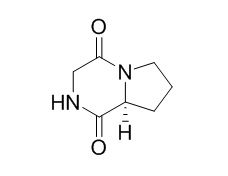Cyclo(Gly-L-Pro)
Cyclo(Gly-(L)-Pro) shows immunostimulatory properties. Cyclo(Gly-l-Pro) exhibits potent inhibition of TNF-α release with the IC50 values of 4.5 ug/mL, respectively, it also exhibits significant diminution of IL-1β and IL-6 mRNA-expression levels and NO production.
Inquire / Order:
manager@chemfaces.com
Technical Inquiries:
service@chemfaces.com
Tel:
+86-27-84237783
Fax:
+86-27-84254680
Address:
1 Building, No. 83, CheCheng Rd., Wuhan Economic and Technological Development Zone, Wuhan, Hubei 430056, PRC
Providing storage is as stated on the product vial and the vial is kept tightly sealed, the product can be stored for up to
24 months(2-8C).
Wherever possible, you should prepare and use solutions on the same day. However, if you need to make up stock solutions in advance, we recommend that you store the solution as aliquots in tightly sealed vials at -20C. Generally, these will be useable for up to two weeks. Before use, and prior to opening the vial we recommend that you allow your product to equilibrate to room temperature for at least 1 hour.
Need more advice on solubility, usage and handling? Please email to: service@chemfaces.com
The packaging of the product may have turned upside down during transportation, resulting in the natural compounds adhering to the neck or cap of the vial. take the vial out of its packaging and gently shake to let the compounds fall to the bottom of the vial. for liquid products, centrifuge at 200-500 RPM to gather the liquid at the bottom of the vial. try to avoid loss or contamination during handling.
J.Soc.Cosmet.Sci.Korea2024, 50(3): 261-270
Asian Pac J Cancer Prev. 2020, 21(4):935-941.
Huazhong Agricultural University2022, pp34.
Plant Cell Tiss Org2017, 479-486
Food Chemistry2023, 137837.
Phytother Res.2022, 35844057.
Journal of Herbal Medicine2024, 48:100950
Journal of Functional Foods2017, 30:30-38
Applied Biological Chemistry2023, 66:42.
Arch Biochem Biophys.2018, 644:93-99
Related and Featured Products
Scand J Immunol. 2012 Aug;76(2):131-40.
Induction of immune-related gene expression in Ctenopharyngodon idella kidney cells by secondary metabolites from immunostimulatory Alcaligenes faecalis FY-3.[Pubmed:
22606987 ]
This study was undertaken to isolate active secondary metabolites from immunostimulatory Alcaligenes faecalis FY-3 and evaluate their activities using grass carp Ctenopharyngodon idella kidney (CIK) cells.
METHODS AND RESULTS:
By applying chromatography techniques and successive recrystallization, three purified metabolites were obtained and identified by spectral data (mass spectrometry and nuclear magnetic resonance) as: (1) phenylacetic acid, (2) p-hydroxyphenylacetylamide and (3) Cyclo(Gly-L-Pro). CIK cells were stimulated by different concentrations (1, 10 and 100 μg/ml) of the isolated compounds, and expression of MyD88, IL-1β, TNF-α, type I-IFN and IL-8 genes at different time points (2, 8 and 24 h) post-stimulation was quantified by real-time PCR. The known immunostimulatory agent lipopolysaccharide (LPS) was used as a positive control. To analyse whether these compounds are toxic to the cells, the methyl tetrazolium assay was employed to measure changes in cell viability. The obtained results revealed that transcribing level of MyD88, an important adaptor molecule in toll-like receptor signalling pathway, was augmented remarkably by all the three isolated compounds and LPS as early as 2-h exposure. These compounds also induced gene expression of cytokines such as IL-1β, TNF-α and type I-IFN. Under the experimental conditions, none of the test compounds is toxic to the CIK cells.
CONCLUSIONS:
These findings demonstrate that the immunostimulatory properties of the three metabolites [phenylacetic acid, p-hydroxyphenylacetylamide and Cyclo(Gly-L-Pro) ] from A. faecalis FY-3 in CIK cells and highlight the potential of using these metabolites as immunostimulants in fish aquaculture.
Bioorg Med Chem Lett. 2015 Dec 15;25(24):5756-61.
Attenuation of TNF-α secretion by L-proline-based cyclic dipeptides produced by culture broth of Pseudomonas aeruginosa.[Pubmed:
26546220 ]
METHODS AND RESULTS:
To identify small molecule inhibitors of TNF-α, bioassay- and LC-MS-guided chemical investigation on EtOAc extract of Pseudomonas aeruginosa ABS-36 culture broth (EEPA) was performed, which yielded four proline-based cyclic dipeptides, Cyclo(Gly-L-Pro) (1), cyclo(l-Pro-l-Phe) (2), cyclo(trans-4-hydroxy-l-Pro-l-Phe) (3) and cyclo(trans-4-hydroxy-l-Pro-l-Leu) (4). Compounds 1 and 3 exhibited potent inhibition of TNF-α release with IC50 values of 4.5 and 14.2μg/mL, respectively, while EEPA showed IC50 of 38.8μg/mL under lipopolysaccharide treated RAW 264.7 cell ELISA assay. Also, marked attenuation of mRNA-expression of TNF-α was shown by all compounds. In vivo testing in rats of EEPA and chemically synthesized 4 validated significant TNF-α reduction with 51% (500mg/kg) and 79% (50mg/kg), respectively. In addition, all compounds exhibited significant diminution of IL-1β and IL-6 mRNA-expression levels and NO production.
CONCLUSIONS:
All samples displayed only weak toxicity to lipopolysaccharide-induced RAW 264.7 cells.



